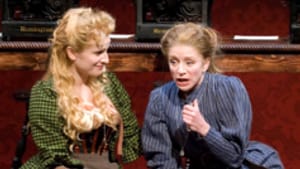Stay in the Loop
BSR publishes on a weekly schedule, with an email newsletter every Wednesday and Thursday morning. There’s no paywall, and subscribing is always free.
Wilma's "Age of Arousal' (2nd review)

The wrong play for the wrong time
JIM RUTTER
As a critic who recently bemoaned the shortage of good female roles on Philadelphia stages (click here), it may seem churlish of me to complain about a play that offers equal roles split between five women and one man. Yet Age of Arousal offers less than the types of relevant roles for actresses I had in mind.
“Wildly inspired” by George Gissing’s 1893 novel The Odd Women, the play describes an “age ripe for change”: 1880s England, where a population imbalance causes women to outnumber men by 500,000, leading suffragists to call for women’s rights and liberation in the political, economic and sexual/domestic realm. In the belief that “money matters for women should never be left to men,” the former radical Mary Barfoot (Mary Martello), and her protégé (and lover) Rhoda Nunn (Krista Hoeppner) found a school to empower these “odd women” who will likely never marry but, feeling redundant without children, must also come to grips with both loneliness and financial freedom.
The arrival of a trio of sisters— the spinsters Alice (Monique Fowler) and Virginia (Roxanne Wellington), and the “pretty Monica” (Larisa Polonsky) who “must marry”— complicates the workings of the school, for the sisters’ baggage includes entrenched sentimentalities about women who lack children and husbands to complete them. The lone man in the play, Mary’s cousin Everard (Eric Martin Brown), provokes a competition between Rhoda and Monica, as both women desire this one available (and suitably reformable) Victorian man. Notwithstanding the story’s lesbian twist, a predictable and quite ordinary love-triangle ensues.
Women’s plight, then vs. now
Despite an overwhelmingly successful and very funny production— the best individual and ensemble acting I’ve seen all season— and Blanka Zizka’s thoroughly engaging direction, this is quite clearly the wrong play for the wrong time.
It’s not the play’s historical aspect that causes the problem. The Wilma’s hit of last season— Athol Fugard’s My Children, My Africa— presented a play that, while written during the last throes of Apartheid South Africa, similarly looked back to the origins of the struggle that brought down that regime. Yet the theme of Fugard’s play still resonates today, as unjust regimes still arise (in Africa and elsewhere) and each generation must decide anew how to fight them.
Yet so much concerning the “plight of women” has changed since the Victorian era. In 2007, more than eight out of ten graduates from veterinary school, half of all medical and law school graduates, nearly 40% of those enrolled in MBA programs, and upwards of 60% of all undergraduates are women.
Why choose Victorian England?
And while the “battle of the sexes” will always resonate, Victorian England still strikes me as the oddest choice for enlightenment. What woman in the Wilma audience does anything but sneer at Mary’s comment that “all men are immoral”? And what theatergoing man today holds or ever held any of the antiquated notions about femininity (“excessive thinking in women withers the uterus and hampers childbearing”) expressed by the one male character in Age of Arousal?
And while I found the use of “thought-speak” incredibly funny to reveal the inner monologues about “boners” and “moist folds of flesh” raging beneath the staid surfaces and tight corsets, Griffiths need only spend a semester at any American university to realize that, if nothing else, women here have been sexually liberated for quite some time.
But what in her Age of Arousal offers a message that speaks to today?
The real issues, glossed over
During brief side conversations, Mary and Rhoda argue about whether women betray their advancement by infighting; whether not entering the workplace makes one less of a woman; and whether taking on a “man’s” dog-eat-dog attitude in the workplace does the same. But Griffiths’ choice to set her play in Victorian times can only make these issues precursors to the larger problems they become, and consequently, they get glossed over, and cannot form the thematic backbone of the play.
Yet women (and the men they work for and live with) still face these issues today. I’m not asking for a treatise that answers these questions. But I can’t tolerate a play that thinks that by merely introducing issues it somehow gains a substance beyond the unusual historical setting, clever theatrical devices and simple plot of a love triangle.
A mere ‘feminist comedy’
By delving into the past, Griffiths takes a dip in the shallow end of the pool, stripping her play of the value of the very ideas she seeks to introduce and leaving us instead with a mere “feminist comedy.” The disconnect between our age and the Age of Arousal not only allows us to laugh, but the advances of the past 120 years contrasted against the archaic elements of the Victorian Era distance us further from a struggle that still rages today.
A play with this much ambition, wit and vigor needs to be set in our age, about our men and women, who benefit from the advances of Mary Barfoot’s struggles yet still need direction.
To read another review by Steve Cohen, click here.
To read another review by Dan Rottenberg, click here.
JIM RUTTER
As a critic who recently bemoaned the shortage of good female roles on Philadelphia stages (click here), it may seem churlish of me to complain about a play that offers equal roles split between five women and one man. Yet Age of Arousal offers less than the types of relevant roles for actresses I had in mind.
“Wildly inspired” by George Gissing’s 1893 novel The Odd Women, the play describes an “age ripe for change”: 1880s England, where a population imbalance causes women to outnumber men by 500,000, leading suffragists to call for women’s rights and liberation in the political, economic and sexual/domestic realm. In the belief that “money matters for women should never be left to men,” the former radical Mary Barfoot (Mary Martello), and her protégé (and lover) Rhoda Nunn (Krista Hoeppner) found a school to empower these “odd women” who will likely never marry but, feeling redundant without children, must also come to grips with both loneliness and financial freedom.
The arrival of a trio of sisters— the spinsters Alice (Monique Fowler) and Virginia (Roxanne Wellington), and the “pretty Monica” (Larisa Polonsky) who “must marry”— complicates the workings of the school, for the sisters’ baggage includes entrenched sentimentalities about women who lack children and husbands to complete them. The lone man in the play, Mary’s cousin Everard (Eric Martin Brown), provokes a competition between Rhoda and Monica, as both women desire this one available (and suitably reformable) Victorian man. Notwithstanding the story’s lesbian twist, a predictable and quite ordinary love-triangle ensues.
Women’s plight, then vs. now
Despite an overwhelmingly successful and very funny production— the best individual and ensemble acting I’ve seen all season— and Blanka Zizka’s thoroughly engaging direction, this is quite clearly the wrong play for the wrong time.
It’s not the play’s historical aspect that causes the problem. The Wilma’s hit of last season— Athol Fugard’s My Children, My Africa— presented a play that, while written during the last throes of Apartheid South Africa, similarly looked back to the origins of the struggle that brought down that regime. Yet the theme of Fugard’s play still resonates today, as unjust regimes still arise (in Africa and elsewhere) and each generation must decide anew how to fight them.
Yet so much concerning the “plight of women” has changed since the Victorian era. In 2007, more than eight out of ten graduates from veterinary school, half of all medical and law school graduates, nearly 40% of those enrolled in MBA programs, and upwards of 60% of all undergraduates are women.
Why choose Victorian England?
And while the “battle of the sexes” will always resonate, Victorian England still strikes me as the oddest choice for enlightenment. What woman in the Wilma audience does anything but sneer at Mary’s comment that “all men are immoral”? And what theatergoing man today holds or ever held any of the antiquated notions about femininity (“excessive thinking in women withers the uterus and hampers childbearing”) expressed by the one male character in Age of Arousal?
And while I found the use of “thought-speak” incredibly funny to reveal the inner monologues about “boners” and “moist folds of flesh” raging beneath the staid surfaces and tight corsets, Griffiths need only spend a semester at any American university to realize that, if nothing else, women here have been sexually liberated for quite some time.
But what in her Age of Arousal offers a message that speaks to today?
The real issues, glossed over
During brief side conversations, Mary and Rhoda argue about whether women betray their advancement by infighting; whether not entering the workplace makes one less of a woman; and whether taking on a “man’s” dog-eat-dog attitude in the workplace does the same. But Griffiths’ choice to set her play in Victorian times can only make these issues precursors to the larger problems they become, and consequently, they get glossed over, and cannot form the thematic backbone of the play.
Yet women (and the men they work for and live with) still face these issues today. I’m not asking for a treatise that answers these questions. But I can’t tolerate a play that thinks that by merely introducing issues it somehow gains a substance beyond the unusual historical setting, clever theatrical devices and simple plot of a love triangle.
A mere ‘feminist comedy’
By delving into the past, Griffiths takes a dip in the shallow end of the pool, stripping her play of the value of the very ideas she seeks to introduce and leaving us instead with a mere “feminist comedy.” The disconnect between our age and the Age of Arousal not only allows us to laugh, but the advances of the past 120 years contrasted against the archaic elements of the Victorian Era distance us further from a struggle that still rages today.
A play with this much ambition, wit and vigor needs to be set in our age, about our men and women, who benefit from the advances of Mary Barfoot’s struggles yet still need direction.
To read another review by Steve Cohen, click here.
To read another review by Dan Rottenberg, click here.
Sign up for our newsletter
All of the week's new articles, all in one place. Sign up for the free weekly BSR newsletters, and don't miss a conversation.

 Jim Rutter
Jim Rutter